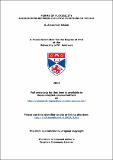Files in this item
Forms of flexibility : associations between executive functions in the rat
Item metadata
| dc.contributor.author | Chase, E. Alexander | |
| dc.coverage.spatial | 156 | en_US |
| dc.date.accessioned | 2013-02-26T16:24:46Z | |
| dc.date.available | 2013-02-26T16:24:46Z | |
| dc.date.issued | 2013-06-25 | |
| dc.identifier.uri | https://hdl.handle.net/10023/3365 | |
| dc.description.abstract | Executive control is a vital cognitive function that facilitates the focussing and shifting of attention, planning and working towards a goal, ignoring distractions, and flexibly responding to novel situations. Disruptions to executive control are seen in many psychiatric and neurodegenerative disorders, as well as healthy ageing, which can be profoundly detrimental. Despite having many effective and well-validated methodologies for detecting and quantifying these deficits, there are very few treatments — pharmacological or otherwise — for ameliorating executive dysfunction. This lack of progress can partly be blamed on difficulties associated with identifying drugs that enhance cognition in preclinical research. The work in this thesis aimed to expand our understanding of executive dysfunction — as well as the tasks that measure it — in rats. In results presented in chapter three, middle-aged rats demonstrated impaired reversal learning on the standard attentional set-shifting task, but this was treatable with a novel drug targeting the N-methyl-D-aspartate receptor. The age impairments seen in this experiment were similar to those previously found in young rats with orbital prefrontal cortex (OFC) lesions. The results of chapter four expanded on this similarity to show that, along with reversal deficits, young OFC-lesioned rats are impaired at forming attentional sets when tested on a modified task. In chapter five, another modified set-shifting task revealed that middle-aged rats also suffer from impaired set-formation, but their reversal learning impairments only manifest before attentional set has been formed — not after. Finally, in chapter six, the putative cognitive enhancer modafinil was found to exacerbate middle-aged rats’ reversal learning deficit, but it also enhanced their subsequent ability to form attentional set. These experiments reveal that modifying the rat attentional set-shifting task can sometimes make it a more effective tool for testing cognitive enhancers in preclinical settings. | en_US |
| dc.language.iso | en | en_US |
| dc.publisher | University of St Andrews | |
| dc.rights | Creative Commons Attribution-NonCommercial-NoDerivs 3.0 Unported | |
| dc.rights.uri | http://creativecommons.org/licenses/by-nc-nd/3.0/ | |
| dc.subject | Executive control | en_US |
| dc.subject | Attention | en_US |
| dc.subject | Set-shifting | en_US |
| dc.subject | Reversal learning | en_US |
| dc.subject | Aging | en_US |
| dc.subject | Prefrontal cortex | en_US |
| dc.subject.lcc | RC553.C64C5 | |
| dc.subject.lcsh | Executive functions (Neuropsychology) | en_US |
| dc.subject.lcsh | Cognition disorders--Animal models | en_US |
| dc.subject.lcsh | Attention | en_US |
| dc.subject.lcsh | Rats | en_US |
| dc.subject.lcsh | Prefrontal cortex | en_US |
| dc.title | Forms of flexibility : associations between executive functions in the rat | en_US |
| dc.type | Thesis | en_US |
| dc.type.qualificationlevel | Doctoral | en_US |
| dc.type.qualificationname | PhD Doctor of Philosophy | en_US |
| dc.publisher.institution | The University of St Andrews | en_US |
This item appears in the following Collection(s)
Except where otherwise noted within the work, this item's licence for re-use is described as Creative Commons Attribution-NonCommercial-NoDerivs 3.0 Unported
Items in the St Andrews Research Repository are protected by copyright, with all rights reserved, unless otherwise indicated.


